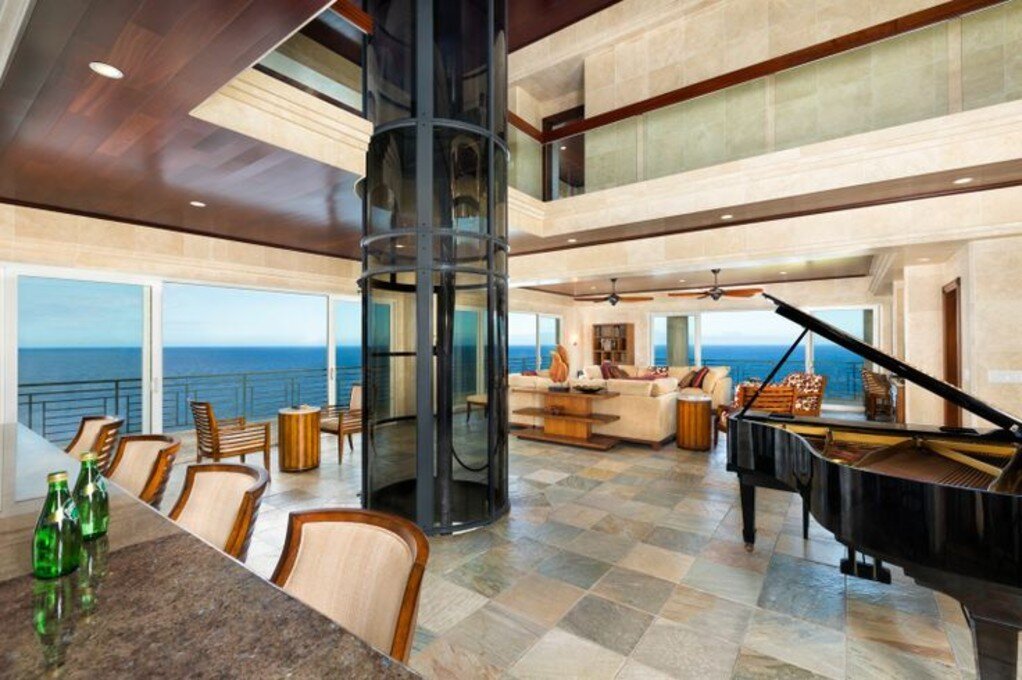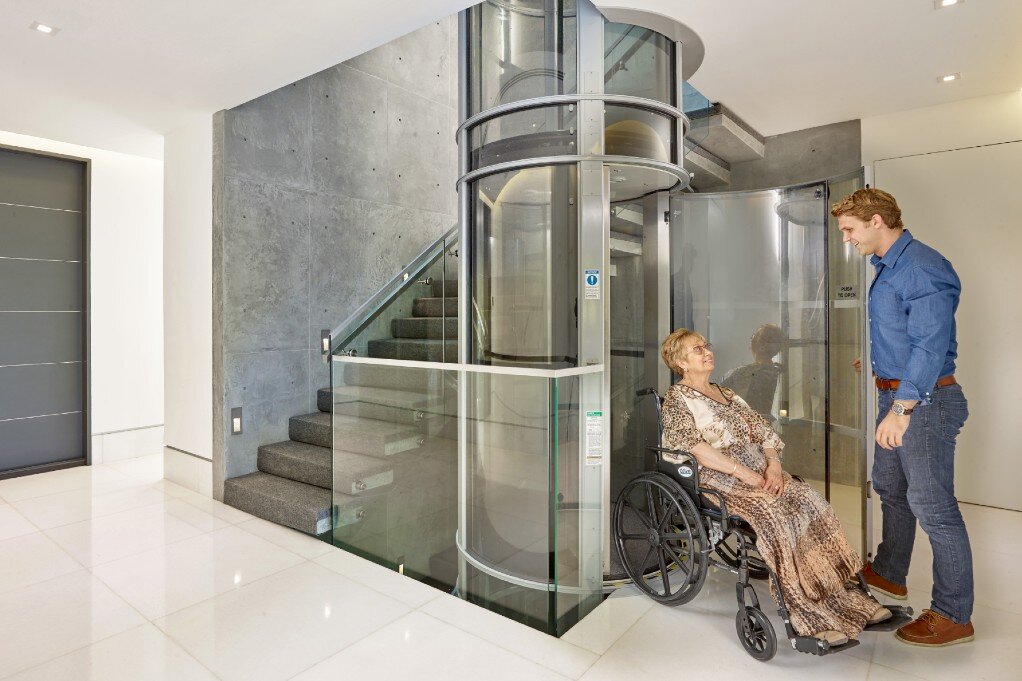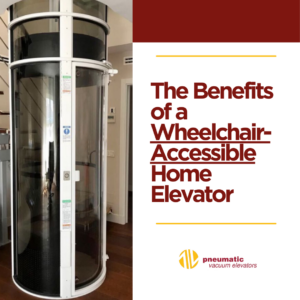Incorporating accessibility features into residential spaces is no longer a luxury; it’s an essential consideration for modern living. While traditional elevators excel at vertical mobility, their installation can be space-consuming and aesthetically disruptive, particularly in existing structures. This is where curved pneumatic residential lifts emerge as a compelling alternative.
Defining Pneumatic Technology
Pneumatic technology utilizes pressurized air as the driving force for mechanical movement. In the context of residential lifts, a piston housed within a pressurized cylinder propels the lift cabin vertically along a guide rail. Compared to traditional electric motors, pneumatic systems offer several advantages:
- Simplicity: Pneumatic systems have fewer moving parts, resulting in a more streamlined and potentially more reliable design.
- Space Efficiency: The relatively compact design of pneumatic cylinders allows for installation in tighter spaces compared to traditional elevator shafts.
- Energy Efficiency: Pressurized air can be a more energy-efficient alternative to electric motors, especially for low-rise applications.
- Quiet Operation: Pneumatic systems generally operate with less noise than traditional elevators, enhancing residential comfort.
Embracing the Curve: Curved Pneumatic Residential Lifts
The inherent flexibility of pneumatic technology extends beyond vertical movement. Curved pneumatic residential lifts cater to unique architectural challenges or design preferences. These lifts navigate bends and turns within a home, offering a seamless integration with curved staircases or unconventional floor plans.
Several factors contribute to the successful implementation of curved pneumatic residential lifts:
- Track Design: Curved guide rails ensure smooth and stable travel along the bend. These rails needs construction from high-strength steel or aluminum, depending on the lift’s weight capacity and operational requirements.
- Drive System: The pneumatic system powering the lift needs adjustment to account for the additional forces acting on the lift cabin during a turn. This might involve incorporating specialized valves, sensors, and control systems to maintain optimal performance on the curved track.
- Safety Features: Curved lifts necessitate enhanced safety protocols. Redundant braking systems, emergency stop mechanisms, and tilt sensors are crucial to ensure passenger safety during ascent and descent along the curve.
Benefits
The unique capabilities of curved pneumatic residential lifts offer a range of advantages for homeowners and architects:
- Accessibility in Unique Spaces: Curved lifts provide accessibility solutions in homes with spiral staircases, circular floor plans, or uneven layouts.
- Enhanced Aesthetics: Curved lifts can become a design statement, adding a touch of elegance and futuristic appeal to a home’s interior.
- Space Optimization: The ability to navigate curves allows for installation in areas where a traditional elevator shaft would not be practical.
- Reduced Noise Pollution: Pneumatic systems generally operate quieter than traditional elevators, minimizing disruptions within the home.
Considerations
While curved pneumatic lifts offer significant benefits, it’s important to consider certain factors before installation:
- Cost: Curved lifts may be more expensive than their straight counterparts due to the complexity of the track design and control systems.
- Load Capacity: Curved tracks might have limitations on weight capacity compared to straight lifts.
- Customization: The options for size and design customization may be more limited compared to standardized straight lifts.
- Maintenance: Regular maintenance schedules are crucial for optimal performance and safety.
Applications
Curved pneumatic lifts cater to a diverse range of residential applications:
- Multi-Level Homes: These lifts provide accessibility in homes with multiple stories, particularly beneficial for individuals with mobility limitations.
- Historical Renovations: Incorporating a curved lift into a historical building renovation can preserve architectural integrity while enabling accessibility.
- Modern Homes: Curved lifts complement the contemporary aesthetic of modern architecture, offering a seamless integration with unconventional layouts.
The Nuances of “Curved” in Pneumatic Residential Lifts
While the term “curved” might seem contradictory when describing a lift that travels within a circular tube, there’s a crucial distinction. Here’s a technical breakdown of why these lifts are categorized as curved:
The Crux Lies in the Track, Not the Tube:
- The circular tube itself doesn’t define the curvature of the lift. It primarily serves as a transparent enclosure for the passenger cabin and provides structural support.
- The defining characteristic of a curved pneumatic residential lift lies in the track design. This track, typically constructed from high-strength steel or aluminum, guides the movement of the lift cabin.
- In a traditional straight pneumatic lift, the track consists of a single, linear segment. Here, the cabin travels purely vertically.
Introducing the Curve:
- In a curved pneumatic lift, the track deviates from a straight line. It incorporates one or more bends to navigate around obstacles, integrate with curved staircases, or adapt to circular floor plans.
- These bends can be gentle arcs or more pronounced turns, depending on the specific architectural constraints.
Engineering the Curve:
- Designing a curved track for a pneumatic lift requires meticulous calculations and specialized engineering. The track curvature needs to be precisely calibrated to ensure:
- Smooth and Stable Travel: The curvature should be designed to minimize lateral forces acting on the cabin during turns, preventing tilting or swaying.
- Optimal Performance: Engineers consider factors like friction, acceleration forces, and pressure distribution within the pneumatic system to ensure smooth operation along the curved track.
- Types of Curved Tracks: There are various configurations for curved tracks, including:
- Single Bend: This involves a single, controlled turn in the track, often used to navigate around a specific obstacle or integrate with a curved landing.
- Double Bend: Here, the track incorporates two bends, potentially creating a U-shaped or S-shaped path for the lift. This configuration might be necessary for navigating tight spaces or complex layouts.
- Continuous Curve: In some cases, the entire track might follow a gentle, continuous curve, seamlessly integrating with a circular floor plan or a spiral staircase.
Safety First: Considerations for Curved Tracks:
- Curved tracks necessitate enhanced safety protocols compared to straight lifts. These include:
- Redundant Braking Systems: Additional braking mechanisms ensure controlled stopping even on a curved section.
- Tilt Sensors: Sensors detect any unintended tilting of the cabin during turns, triggering safety protocols if necessary.
- Advanced Control Systems: Sophisticated control systems monitor and adjust pressure distribution within the pneumatic system to maintain stability on the curve.
Frequently Asked Questions (FAQs) about Curved Pneumatic Residential Lifts
1. Are curved pneumatic lifts safe?
Yes, curved pneumatic lifts can be very safe when properly designed, installed, and maintained. They incorporate redundant braking systems, tilt sensors, and advanced control systems to ensure passenger safety on curved sections of the track. All curved pneumatic lifts must adhere to relevant safety standards and undergo rigorous inspections before operation.
2. How much does a curved pneumatic lift cost compared to a straight lift?
Curved pneumatic lifts tend to be more expensive than their straight counterparts. This is due to the increased complexity of the curved track design, specialized engineering requirements, and potentially more sophisticated control systems.
3. Can I customize a curved pneumatic lift for my home?
Customization options for curved lifts may be more limited compared to standardized straight lifts. However, some manufacturers offer a degree of customization in terms of track layout, cabin size, and finishes. It’s essential to discuss your specific needs and space constraints with a qualified dealer to determine the feasibility of customization.
4. Are curved pneumatic lifts noisy?
One of the benefits of pneumatic technology is its relatively quiet operation. While there will be some sound associated with the movement of the lift, it’s generally quieter than traditional elevators with electric motors. This is particularly advantageous in residential settings where noise minimization is desired.
5. How often does a curved pneumatic lift need maintenance?
Regular maintenance is crucial for the optimal performance and safety of any lift system. The specific maintenance schedule for a curved pneumatic lift will depend on the manufacturer’s recommendations and usage patterns. Generally, it involves periodic inspections, lubrication of moving parts, and system checks to ensure everything is functioning correctly.
Conclusion:
The term “curved” for pneumatic residential lifts accurately reflects the complexity of their track design. While the enclosing tube might be circular, it’s the engineered curves within the track that define the lift’s ability to navigate non-linear paths, offering a unique solution for accessible and aesthetically pleasing residential mobility.








